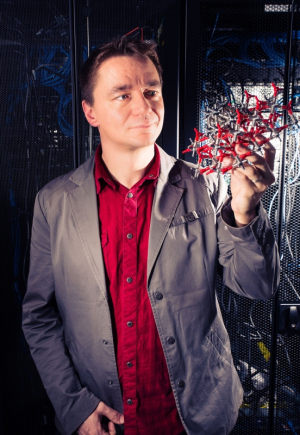Lars Grabow has been given a $750,000 grant to solve a multi-billion dollar problem.
Methane, the majority component of natural gas, is cheap and plentiful, thanks in large part to hydraulic fracturing, or fracking. Ideally, it could be converted into rarer and far more valuable chemicals like methanol, ethane or ethylene, all of which have dozens of uses, many involving the creation of plastics and polymers.
Easier said than done.
This research falls under the umbrella of catalysis, which uses one material to initiate or speed up a chemical reaction that changes other substances. “For more than 30 years, people have tried to do this chemistry,” said Grabow, an assistant professor of chemical and biomolecular engineering with the University of Houston Cullen College of Engineering. “It’s the Holy Grail of catalysis…If you could invent a catalyst that selectively converts methane into ethylene, you’d be a billionaire right there.”
In addition to the economic value of such a discovery, Grabow said, Holy Grail status is conferred by the methane molecule’s strong carbon-hydrogen bonds and its unique shape. It is perfectly symmetrical, consisting of one carbon atom surrounded by four hydrogen atoms.
This symmetry means there’s no obvious way to split a single hydrogen atom from methane, the first step in converting the gas into a new chemical. In fact, this split can only be carried out at very high temperatures. At these temperatures, the remaining methyl radical (one carbon with three hydrogens) detaches from the surface of the catalyst and simply burns off. As a result the methane is entirely wasted.
The key to solving this problem, Grabow believes, is finding the oxidizing agent – essentially a molecule that can accept electrons from another molecule – that is the most effective at reacting with and separating hydrogen atoms from methane molecules.
“We want to understand what role the oxidizing agent plays in this process and if we do that then we want to use that knowledge to design a catalyst that can break the carbon-hydrogen bond at lower temperatures,” he said.
Grabow then, will run simulations exploring the ability of different combinations of catalysts (including various metal alloys, metal-oxides and zeolite crystals) and oxidizing agents (such as oxygen, hydrogen peroxide and carbon dioxide) to detach a hydrogen atom from methane molecules at low temperatures. This should keep the methyl on the surface of the catalyst, allowing researchers to then convert it to more valuable chemicals.
Promising combinations identified by Grabow’s simulations will then be explored through experiments conducted by Bill Epling, associate professor of chemical and biomolecular engineering at the Cullen College and Grabow’s collaborator on the project.
If they’re successful, said Grabow, their findings will only cover the first half of converting methane into other chemicals. Additional research will be needed to find ways to best transform the remaining and stable methyl fragment into the materials like methanol, ethane and ethylene.
Success in just the first part of the reaction, though, would be a major breakthrough, said Grabow.
“If we can find a way to separate one hydrogen atom from a methane molecule, our hope is that processes that aim to upgrade methane to a higher value product can be carried out more selectively. No one has understood this process. It’s a very fundamental question we’re trying to answer with a very big potential impact.”
Grabow’s research efforts are being supported by one of the world’s leading petrochemical companies, SABIC.
